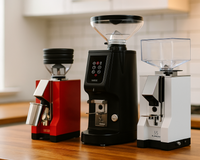Choosing between a single boiler and a dual boiler espresso machine is one of the most important decisions you’ll make as a home barista. Both can produce excellent espresso, but the right fit depends on your workflow, the drinks you love, and how often you serve others.
This guide dives deep into what sets them apart—covering pros and cons, warm-up and recovery times, energy use, taste consistency, and real-world scenarios. By the end, you’ll know which type belongs on your counter.
How They Work
Single Boiler (SBDU – Single Boiler Dual Use)
A single boiler machine has one boiler that alternates between brewing and steaming temperatures.
-
Brew temp: ~195–205°F (ideal for espresso).
-
Steam temp: above 212°F (for milk frothing).
Since the boiler can’t hold both temperatures simultaneously, you brew your shot first, then switch to steam mode (or the other way around). This “mode switching” adds time but keeps the design simple, compact, and affordable.
Shop all our single boiler espresso machines >
Dual Boiler (DB)
A dual boiler machine has two independent boilers:
-
One dedicated to brewing.
-
One dedicated to steaming.
This allows you to brew and steam at the same time, with each boiler held at its own ideal temperature. Most dual boilers also include PID controllers for rock-solid temperature stability.
Shop all our dual boiler espresso machines >
Pros and Cons at a Glance

| Feature | Single Boiler | Dual Boiler |
|---|---|---|
| Brew & steam simultaneously | ❌ No | ✅ Yes |
| Temperature stability | Good with PID | Excellent |
| Warm-up time | Shorter | Longer |
| Recovery speed | Slower | Fast |
| Milk steaming | Adequate | Powerful |
| Size | Smaller | Larger |
| Complexity | Simple | More components |
| Purchase price | Lower | Higher |
| Energy use | Lower | Higher |
Warm-Up and Recovery Times
Warm-up time matters if you’re rushing before work. Here’s a general guide:
-
Single Boiler: 5–10 minutes to reach brew temperature, though a few more minutes are needed for the group head and portafilter to heat soak.
-
Heat Exchanger (HX): 15–20 minutes on average for stable temps.
-
Dual Boiler: 20–30 minutes for both boilers and the group to be fully stable (some larger machines may need 30–40 minutes).
Recovery time is equally important.
-
Single boiler machines take longer because you must raise the boiler temperature to steam and then cool it down again before brewing the next shot.
-
Dual boiler machines recover nearly instantly because the brew and steam circuits are independent.
Energy Use and Operating Costs
Energy usage is shaped by boiler size and count:
-
Single boilers draw less power and lose less heat at standby.
-
Dual boilers draw more because they keep two heating circuits active.
If you plan to leave your machine on all day, a dual boiler will cost more to run. The good news: timers, smart plugs, or eco modes can help reduce wasted power.
Taste, Consistency, and PID Control
When it comes to flavor, temperature stability is everything.
-
A PID-equipped single boiler can hold brew temp within 1–2°F, producing consistently balanced espresso. Without PID, you may need to “temperature surf” (time shots to the boiler’s heating cycle).
-
A dual boiler with PID is the gold standard, offering rock-solid stability and letting you dial in light roasts with precision.
Important takeaway: Single vs dual doesn’t dictate whether your espresso tastes good—it dictates how consistently you can repeat good results, especially when brewing multiple drinks or switching between espresso and milk.
Related: What is PID Temperature Control?
Which One Fits You? Real-World Scenarios

1. Mostly Straight Espresso, Few Milk Drinks
If you mainly drink espresso or americanos, with the occasional cappuccino, a single boiler with PID is cost-effective, compact, and energy-efficient. You’ll learn the rhythm of brew → switch → steam without much hassle.
2. Daily Lattes or Cappuccinos
If you steam milk daily, or if multiple household members drink milk-based drinks, the dual boiler is worth the investment. Simultaneous brew and steam makes mornings smoother and milk texture more consistent.
3. Entertaining Friends and Family
For brunch parties or family gatherings where you’ll pull shot after shot, dual boilers shine. You’ll have the steam power and consistency to keep up without frustrating pauses.
If budget is tighter, consider a heat exchanger (HX) machine—it can brew and steam at the same time, though it requires a bit more skill (managing flush routines).
Related: Fall Coffee Drinks to Warm Your Soul
Where Heat Exchangers Fit In
Heat exchanger (HX) machines are a third option worth mentioning.
-
They use a single large steam boiler.
-
Brew water is drawn through a heat exchanger tube inside the steam boiler.
-
This allows simultaneous brew and steam, but temp stability depends on flush routines.
HX machines are a solid middle ground between single and dual boilers—often more affordable than dual boilers while offering faster workflow than single boilers.
Shop all our heat exchanger espresso machines >
Roast Pairing and Workflow Tips
-
Dark roast lovers: Both single and dual boilers perform well. Dual boilers make it easier to steam milk consistently for lattes or cappuccinos.
-
Light roast enthusiasts: Temperature precision matters more, and dual boilers with PID offer an edge.
-
Workflow hacks:
-
Use a smart plug to schedule warm-up before you wake.
-
Pre-heat cups and portafilters for consistency.
-
Batch prep milk for multiple drinks to minimize back-and-forth with single boilers.
-
Is a Dual Boiler Worth It?
The big question: should you spend the extra money?
-
Yes, if: you make milk drinks daily, entertain, or want maximum control and consistency.
-
No, if: you mostly drink espresso or americanos, and you’re happy with a simpler workflow.
Remember, both can produce café-quality espresso. It’s about convenience and lifestyle more than absolute quality.
Frequently Asked Questions
Do dual boilers make better espresso?
Not inherently. Both can make excellent shots. The difference is in consistency and workflow—dual boilers let you replicate great shots more easily under heavy use.
Do dual boilers use more electricity?
Yes. They run two boilers, often larger ones. Energy-saving practices (timers, eco modes) can help.
How long do single vs dual boilers take to heat up?
Single boilers: ~5–10 minutes. Dual boilers: ~20–30 minutes for full stability.
Is a heat exchanger a good compromise?
Yes, especially if you want to steam and brew simultaneously without the cost of a dual boiler. Just know you’ll need to master flush routines.
Which is better for light vs dark roast?
Light roasts benefit from dual boilers with PID for precise temp control. Dark roasts are more forgiving and work well on either boiler type.
Final Verdict
If you’re buying your first prosumer espresso machine, here’s the simplest way to decide:
-
Single boiler = compact, budget-friendly, great for espresso lovers with occasional milk drinks.
-
Dual boiler = powerhouse for milk-drink households and entertainers who want café-level workflow at home.
-
Heat exchanger = smart middle ground when you want speed without dual boiler cost.
At Cliff & Pebble, we stock carefully chosen models across all categories, from entry-level single boilers to flagship dual boilers like the Lelit Bianca V3. Every machine comes with our 365-day in-home trial, free shipping, and no sales tax—so you can find the right fit without stress.














